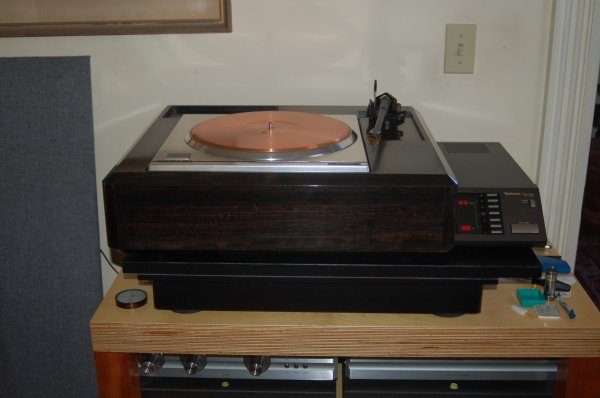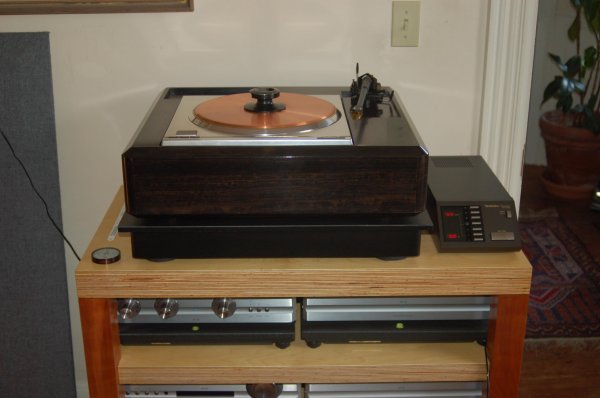That was why I suggested direct comparisons such as these don't often occur for the obvious reason so kudos to you and David
+1
This is very interesting, Peter! Thank you for writing up the report!
That was why I suggested direct comparisons such as these don't often occur for the obvious reason so kudos to you and David
. . . I do find it fascinating that Mike L has gone to belt drive in the form of the AS after, what, 15 years as a deep convert to DD w the Rockport and NVS.
. . .
However, I still feel rim/idler offers some interesting different perspectives on music making in terms of potential advantages in rhythmic propulsion and energy, but maybe at the expense of increased noise flr.
Many thanks Peter. I've toyed with going to an all out assault on the TT side, but for now, I'm satisfied......
(...) Regarding the overall differences, I did write and observe at the time, that often the differences were "pretty subtle". What I found most interesting is that differences between various recordings were more pronounced with the SME than with the SP10 which leads me to conclude that the latter was glossing over differences or imposing a slightly greater coloration over all of the music than was the SME.
During the comparison, David and I did speak to two people very familiar with SP10s and these plinths and copper mats. There was some disagreement but one gentleman thought that the SP10s sound best in their original obsidian? plinths or even no plinth at all. I just don't know enough about the various elements of the design and simply considered it as the whole combination presented. It is very similar to the SP10 combination that Albert Porter used when he had his SME V-12 and Supreme cartridge.
Dear Spirit,
Your view on noise floor of an idler drive is quite contradicting to what I hear from my EMT 927. Even when I take out my grounding cable from the EMT, I find its noise floor surprising low..as low as the AF1 and the Kronos. Amazing actually, given it is 56 years old with just normal cheap cables.
Kind regards,
Tang
It is one more think that puzzled me in your comparison - IMHO the SME's are not the champions of detail and nuance.
What type of phono unit has your friend? The standard controller of the SP10's is very noisy - could we admit that the glare you perceived was due to noise interaction with your SS XP25?
It is one more think that puzzled me in your comparison - IMHO the SME's are not the champions of detail and nuance.
What type of phono unit has your friend? The standard controller of the SP10's is very noisy - could we admit that the glare you perceived was due to noise interaction with your SS XP25?
My SP10 had the original obsidian - it compromised the bass performance of the turntable, but had a full sound. A plinth should be mandatory in order to dissipate the energy created in the DD motor and bearing. You have a point on these custom plinths - they can sound very different and their characteristics can easily change the sound signature of the motor. Very recently I played around with a Garrard 401 and a few plinths and this was one of the reasons I moved away - I understood I risked entering a very time consuming never ending experience.
It is one more think that puzzled me in your comparison - IMHO the SME's are not the champions of detail and nuance.
What type of phono unit has your friend? The standard controller of the SP10's is very noisy - could we admit that the glare you perceived was due to noise interaction with your SS XP25?
My SP10 had the original obsidian - it compromised the bass performance of the turntable, but had a full sound. A plinth should be mandatory in order to dissipate the energy created in the DD motor and bearing. You have a point on these custom plinths - they can sound very different and their characteristics can easily change the sound signature of the motor. Very recently I played around with a Garrard 401 and a few plinths and this was one of the reasons I moved away - I understood I risked entering a very time consuming never ending experience.


Micro, I respect your opinion and I do not know under what conditions you formed your views about the range of SME turntables. I will say, that after directly comparing my SME Model 10A with 9" V arm to my Model 30/12A with the same 9"arm and cartridge, there was quite an improvement in the areas of detail and nuance, particularly in the lower frequencies and in terms of extraction of information probably due to better isolation and vibration/noise management. Then again when I later added the 12" SME V-12 arm and once again when I improved cartridges. In my system, the conclusion I reached is that the 30/12 provides an exceptionally neutral platform and it excels at detail and nuance demonstrated by the degree of information which is extracted from the grooves at the source. That is one reason I take LPs well known to me to audition on other people's turntables and in their systems. This is probably also why Bruce B selected the SME Model 30 for his business. We just seem to have a difference of opinion and perhaps experience regarding SME. That is fine.
(...) The Technics power supply was plugged into the same Transparent conditioner.(...)
(...) Your claim does have me thinking about compatibility though, so it might be worth taking my XP25 phono stage over to David's house to see if we hear the hardness/glare with that combination in his system. (...)
Ked, is Mik aka 108CY?
I had a great chat w him the other day.
Fascinating stuff, Peter.
I remain convinced that excessive servo feedback controlling speed in DDs results in this glare or etch.
So that average speed accuracy is greater w DDs, but moment to moment it may be worse than belt drives, and continued micro adjustments instill an underlying subliminal unease.
| Steve Williams Site Founder | Site Owner | Administrator | Ron Resnick Site Owner | Administrator | Julian (The Fixer) Website Build | Marketing Managersing |





